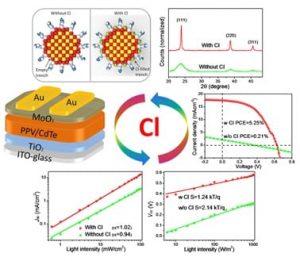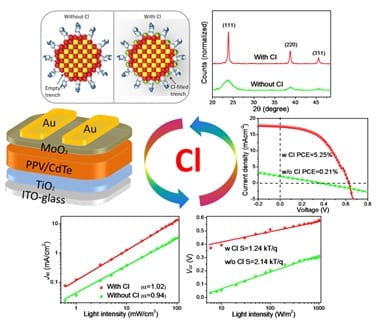Aqueous-processed polymer/nanocrystals hybrid solar cells have been investigated widely in recent years, as they provide an environmentally-friendly protocol to fabricate efficient photovoltaic devices. High-quality nanocrystals are vital to achieve high-performance hybrid solar cells. As an important constituent of the hybrid composite materials, in-depth investigation on CdTe nanocrystals related properties is extraordinarily insufficient. Previously, it has been noticed that CdTe nanocrystals synthesized with CdCl2 as Cd precursors was necessary for high-efficient hybrid solar cells. However, the roles of Cl in aqueous-processed polymer/CdTe hybrid solar cells are still not clear. Therefore, further improvement of the device performance is limited.
 In this work, Yang’s team systematically investigate the effects of chlorine on the synthesis of aqueous CdTe nanocrystals, crystal growth, defect passivation, photocarrier dynamics and device performance. The device performance of aqueous-processed polymer/CdTe hybrid solar cells is dramatically improved after incorporating CdTe nanocrystals with Cl. The Cl in as-prepared nanocrystals can promote crystal growth in sintered process, and the residual Cl on CdTe Nanocrystals surface can efficiently passivate the surface trap states. These two aspects lead to reduced nongeminate recombination and improved charge extraction efficiency. This work suggests that the photovoltaic performance of hybrid solar cells can be further promoted through adopting improved passivation methods to reduce trap states on the grain boundaries in the future work.
In this work, Yang’s team systematically investigate the effects of chlorine on the synthesis of aqueous CdTe nanocrystals, crystal growth, defect passivation, photocarrier dynamics and device performance. The device performance of aqueous-processed polymer/CdTe hybrid solar cells is dramatically improved after incorporating CdTe nanocrystals with Cl. The Cl in as-prepared nanocrystals can promote crystal growth in sintered process, and the residual Cl on CdTe Nanocrystals surface can efficiently passivate the surface trap states. These two aspects lead to reduced nongeminate recombination and improved charge extraction efficiency. This work suggests that the photovoltaic performance of hybrid solar cells can be further promoted through adopting improved passivation methods to reduce trap states on the grain boundaries in the future work.

















